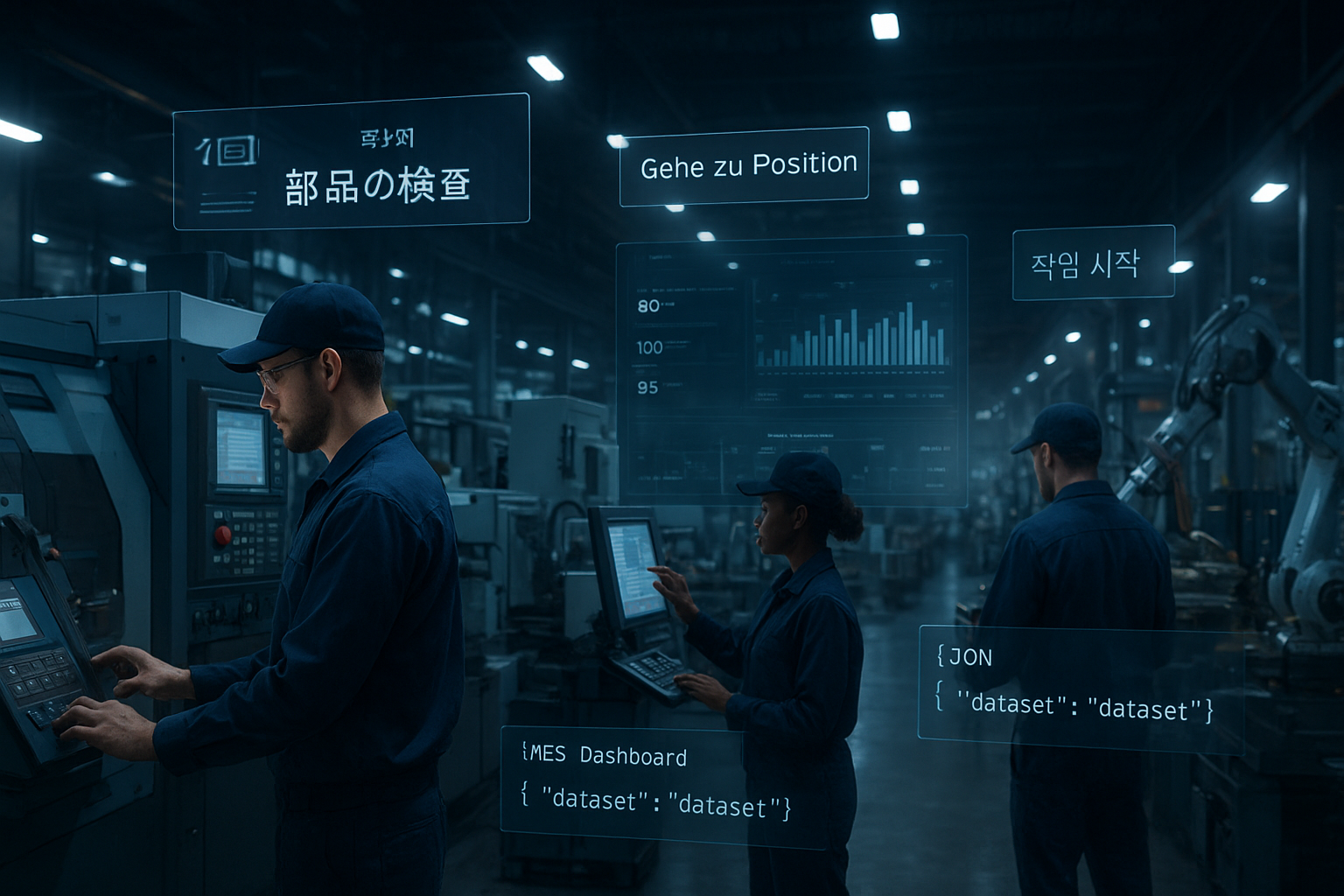When a line stops and a manager needs an answer fast, a single well-crafted prompt can make the difference between minutes of downtime and a safe, correct recovery. For CTOs and plant managers scaling operations across sites and shifts, the art of manufacturing prompt engineering becomes the new human–machine interface: a disciplined way to translate operator intent into precise interactions with MES, SCADA, and maintenance systems.

Why prompts are the new HMI for AI-driven factories
Traditional HMIs present menus and measurements; modern factories need conversational, context-aware assistants that bridge human intent and system data safely and consistently. A shop floor AI assistant built with manufacturing prompt engineering reduces ambiguity by directing the language model to use standardized templates and controlled vocabularies. Instead of open-ended recommendations, prompts can force safe refusals for hazardous suggestions and annotate every recommendation with provenance and risk levels.
This is not about replacing people. It is about making every suggestion auditable and defensible. Human-in-the-loop controls are embedded for critical actions, logging the prompt, the model’s suggestion, the data sources consulted, and the operator’s final decision. That log becomes both an operational record and an input to continuous improvement.
Designing prompts for industrial contexts
High-value prompts in manufacturing are precise: they reference equipment IDs, fault codes, units of measure, and acceptable thresholds. Controlled vocabularies prevent term drift—if a pump is identified as P-301 across systems, prompts force that ID rather than free-text descriptors. Multilingual prompts ensure that operators on different shifts or in different countries receive consistent guidance, which directly improves adoption and safety.
Another essential practice is schema-constrained outputs. When a shop floor AI assistant returns structured JSON describing a next-best-action, downstream automation and CMMS write-back can parse it deterministically. A small example of a constrained output might look like this:
{
"equipment_id": "P-301",
"timestamp": "2025-10-29T10:12:00Z",
"diagnosis": "Bearing temperature spike above 85C",
"confidence": 0.87,
"next_action": "isolate_motor",
"action_reason": "temperature trend + vibration increase",
"provenance": ["sensor:temp_sensor_12","alarm_log:ALM-452","historical_incident:INC-2019-07"],
"safety_gate": "requires_supervisor_approval"
}Constrained outputs like this let controllers, CMMS, and MES automate low-risk steps and escalate anything flagged by safety gates to humans.
Use cases with measurable ROI
The narrative around predictive maintenance prompts and troubleshooting copilots becomes tangible when tied to clear outcomes. An SOP assistant that retrieves task-specific steps with visuals reduces the time an operator needs to orient to unfamiliar equipment. Troubleshooting copilots that correlate live alarms with historical incidents reduce mean time to repair by suggesting targeted checks. Predictive maintenance prompts summarize sensor anomalies into prioritized next-best-actions, increasing the probability that maintenance teams address the right issue before failure.
These are not abstract benefits. Properly designed prompts lead to reductions in MTTR, improved first-pass yield, and measurable downtime avoided. Each prompt should therefore be associated with a hypothesis: what KPI will this improve, how will we measure it, and what thresholds count as success.
Integration blueprint: MES/SCADA/CMMS + RAG
Connecting prompts to trusted operational data is what turns clever language models into reliable shop floor copilots. The pragmatic pattern is RAG (retrieval-augmented generation) over trusted sources: SOPs, equipment manuals, incident logs, and parts catalogs. Prompts orchestrate RAG queries and then demand provenance in every response so operators can see which documents and sensor feeds informed a suggestion.

For safety and auditability, MES and SCADA queries should be read-only from the model’s perspective. Outputs include clear provenance links back to the specific MES records or SCADA time ranges used. When a suggested repair requires action in the CMMS, prompts produce schema-constrained work orders that can be validated and then written back by the integration layer.
Architecturally, this looks like an edge-capable gateway: low-latency on-premise inference or prompt orchestration, a RAG index that caches SOPs and the latest manuals, and secure APIs to MES/SCADA/CMMS that enforce permissions and provide an audit trail for every read and write.
Quality, safety, and performance metrics
Good prompt engineering defines the metrics up front. For manufacturing teams, that means tracking MTTR reduction, first-pass yield improvement, and downtime avoided attributable to AI assistance. Equally important are safety metrics. Prompts must implement zero-tolerance gates for hazardous recommendations: if the model proposes an action that could put people or equipment at risk, the response should include a mandatory human authorization step and explicit safety rationale.
Operator adoption rates and satisfaction—especially across languages and shifts—round out the performance picture. Measuring which prompts are used, how often outputs are accepted or overridden, and the time-to-resolution after a prompt-led suggestion creates a feedback loop to refine prompt wording, schema constraints, and the RAG corpus.
Rollout strategy across plants
Scaling prompt engineering across a network of plants requires discipline. Start with a lighthouse line to validate core prompts and the prompt library by process type. Build a canonical set of controlled vocabularies and a shared prompt catalog that can be extended per plant. Edge deployment is critical for low-latency responses and resilience in environments with intermittent connectivity; local RAG caches and offline fallbacks keep assistants useful even when upstream systems are temporarily unreachable.
Training supervisors and continuous improvement teams to author and evaluate prompts is part of the rollout. Prompts should be versioned, evaluated against KPIs, and refined through periodic reviews. This keeps the library lean and ensures that safety gates and governance rules are maintained uniformly across sites.
How we help: From strategy to working copilots
Delivering reliable shop floor copilots is a blend of operational strategy and technical execution. Services that align prompt engineering with OEE and safety KPIs, integrate MES/SCADA/CMMS securely with RAG, and supply curated prompt libraries and MLOps practices accelerate impact. Evaluation suites that track prompt performance, provenance coverage, and operator acceptance translate the art of prompt engineering into measurable business outcomes.
For CTOs and plant managers, the promise is concrete: a safer, more consistent way for teams to interact with operational systems, faster diagnostics, and predictive maintenance that acts earlier. The next step is to codify your controlled vocabularies, define the safety gates your prompts must enforce, and begin building a reproducible prompt library that scales from line to plant to network.
Ready to translate operator intent into reliable actions? Start by capturing your critical SOPs, fault codes, and equipment IDs, then design constrained prompt templates that demand provenance and safety gates. With these foundations, shop floor AI assistants become dependable copilots rather than curious experimentations, and manufacturing prompt engineering moves from art to operational standard.

















